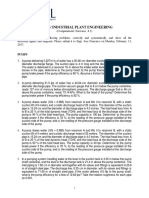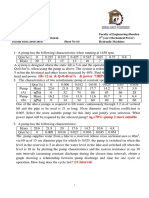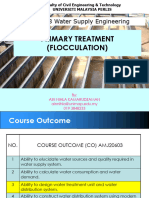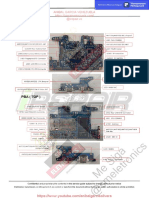PS - Reciprocating Pump
PS - Reciprocating Pump
Uploaded by
L.ABHISHEK KUMARCopyright:
Available Formats
PS - Reciprocating Pump
PS - Reciprocating Pump
Uploaded by
L.ABHISHEK KUMAROriginal Title
Copyright
Available Formats
Share this document
Did you find this document useful?
Is this content inappropriate?
Copyright:
Available Formats
PS - Reciprocating Pump
PS - Reciprocating Pump
Uploaded by
L.ABHISHEK KUMARCopyright:
Available Formats
Reciprocating Pump
1. A single acting reciprocating pump has a 15cm piston with a crank of radius 15cm. The delivery pipe is 10cm
diameter. At a speed of 60rpm, 310 lps of water is lifted to a total height of 15m. Find the slip, coefficient of
discharge and theoretical power in kW required to drive the pump. [Slip = 2.52%, Coeff. of discharge =
0.975, Pt = 0.778kW]
2. A three throw pump has a 20cm diameter cylinder and a stroke of 40cm. The pump is required to deliver 5000
lpm of water at a static head of 80m. Friction losses can be taken 2.0m in the suction pipe and 18m in the
delivery pipe. Assume a slip of 2% and the pump efficiency of 90%. Neglecting the velocity head in the
delivery pipe, determine the speed of the pump and the power required. [N = 135.4 rpm, P = 90.73kW]
3. A single acting reciprocating pump has the its cylinder diameter 15cm, stroke length 30cm, suction head
2.5m. The diameter of the suction pipe is 5.0cm and the length is 5.0m. Assuming atmospheric pressure as
10.0m of water (abs) and vapor pressure as 2.0m of water (abs) determine the maximum speed at which the
pump can be run without cavitation. [N = 27 rpm]
4. A single acting reciprocating pump has 20cm cylinder with a stroke of 40cm. The suction pipe is 10cm
diameter and 5m long. If the speed of the pump is 30 rpm, determine the maximum suction lift if the
cavitation occurs at 2.5m of water (abs). Assume atmospheric pressure as 10.0m of water (abs). [Hs = 3.476
m]
5. A single acting reciprocating pump has a 25cm cylinder with a stroke of 40cm. The diameters of suction and
delivery pipes are 15cm and 20cm respectively. If the piston makes 40 strokes/min, estimate the maximum
velocity and acceleration of water in the suction and delivery pipes. [Vsmax = 2.327 m/s, Vdmax = 1.309 m/s,
asmax = 9.749 m2/s, admax = 5.484 m2/s]
6. A single acting reciprocating pump has cylinder diameter 10cm, stroke 25cm. The static suction head is 4.0m,
diameter of the suction pipe is 5.0cm and the length is 6.0m. The static delivery head is 16.0m, diameter of
the delivery pipe is 5.0cm and the length is 25.0m. If the crank speed is 30rpm, estimate the pressure head on
the piston at the (i) beginning, (ii) mid and (iii) end of the suction and delivery strokes. Assume atmospheric
pressure as 10.0m of water (abs) and the friction factor as 0.02. [(i) 2.982 m, (ii) 5.698 m, (iii) 9.018 m]
7. A double acting reciprocating pump has 25cm cylinder with a stroke of 40cm. The suction pipe is 5.0cm
diameter and 3.0m long. If the piston executes 50 strokes/minute, determine the minimum diameter of suction
pipe to prevent cavitation. Cavitation occurs at 2.5m water (abs). Assume atmospheric pressure as 10.0m of
water (abs). [ds = 9.86 cm]
8. A single acting reciprocating pump has a stroke length of 45cm and a cylinder diameter of 30cm. The suction
pipe is 6m long and has a diameter of 15cm. The water level in the sump is 3.0m below the cylinder. (i)
Calculate the maximum speed of the pump, if cavitation is known to occur at 2.5m of water (abs). (ii) If an air
vessel is fitted on the suction side at a length of 2.0m from the cylinder, calculate the admissible maximum
speed and the percentage change in the discharge. Assume atmospheric pressure as 10.0m of water (abs) and
the friction factor as 0.02.
[(i) N = 27.3 rpm; (ii) N = 47 rpm, 72% increase in discharge after fitting the air vessel]
9. A double acting reciprocating pump has its cylinder diameter 20cm, stroke length 40cm. The diameter of the
suction pipe is 10cm and the crank speed is 90 rpm. If an air vessel is fitted on the suction side, calculate the
flow into or out of the air vessel when the crank angle is (i) 45 0 and (ii) 1500. [(i) 0.00419 m3/s out of air
vessel, (ii) 0.00807 m3/s into air vessel]
10. A single-acting reciprocating water pump, with a bore and stroke of 150 mm and 300mm respectively, runs at
2.51 rad·s−1 (0.4 rev/s). Suction and delivery pipes are each 75mm diameter. The former is 7.5 m long and
the suction lift is 3 m. There is no air vessel on the suction side. The delivery pipe is 300 m long, the outlet (at
atmospheric pressure) being 13.5m above the level of the pump, and a large air vessel is connected to the
delivery pipe at a point 15m from the pump. Calculate the absolute pressure head in the cylinder at beginning,
middle and end of each stroke. Assume that the motion of the piston is simple harmonic, that losses at inlet
and outlet of each pipe are negligible, that the slip is 2%, and that friction factor f for both pipes is constant at
0.01. (Atmospheric pressure ≡ 10.33 m water head.) [ Suction stroke: 4.43m, 6.87m, 10.23m; Delivery stroke:
31.34m, 26.47m, 19.75m]
You might also like
- Iit-Jee Organic Chemistry by NJ Sir: S.No Name of Chapters Page NoDocument1 pageIit-Jee Organic Chemistry by NJ Sir: S.No Name of Chapters Page NoL.ABHISHEK KUMARNo ratings yet
- Dicktator Genitalia 0.3 For G8M: Mini-TutorialDocument4 pagesDicktator Genitalia 0.3 For G8M: Mini-TutorialAurora100% (1)
- Pumps LectureDocument38 pagesPumps LectureRichard Manongsong100% (1)
- Science: Common Atmospheric PhenomenaDocument33 pagesScience: Common Atmospheric PhenomenaMelanie Tagudin Trinidad80% (5)
- UNIT 5 HydraulicsDocument31 pagesUNIT 5 Hydraulicsnandu20No ratings yet
- PS - Centrifugal PumpDocument2 pagesPS - Centrifugal Pumpmukherjeedalia79No ratings yet
- Tutorial Sheet On Reciprocating PumpDocument1 pageTutorial Sheet On Reciprocating PumpShashikant GuptaNo ratings yet
- Problems On CF PumpDocument2 pagesProblems On CF PumpL.ABHISHEK KUMARNo ratings yet
- Sheet 04 20-21 Flow MeasurementDocument2 pagesSheet 04 20-21 Flow MeasurementAvishek BiswasNo ratings yet
- Tutorial 2Document1 pageTutorial 2Abhishek JhaNo ratings yet
- Chapter No 4Document6 pagesChapter No 4gotu123No ratings yet
- 14 MarksDocument4 pages14 MarksmohanNo ratings yet
- Venturimeter, Orifice, PitotDocument2 pagesVenturimeter, Orifice, PitotVoora GowthamNo ratings yet
- Problem Set 1Document15 pagesProblem Set 1Silva, Joe Mari T.No ratings yet
- Assignment Topic AlternatifDocument6 pagesAssignment Topic AlternatifGalihmery DamaiantiNo ratings yet
- Assignment IVDocument2 pagesAssignment IVMANOJ MNo ratings yet
- MEC 4106 Pumps Tutorial SheetDocument6 pagesMEC 4106 Pumps Tutorial SheetleitchNo ratings yet
- Sample ProblemsDocument2 pagesSample ProblemsCharlyn PandaNo ratings yet
- 2135 Tutorial 1Document4 pages2135 Tutorial 1Eezhar JumadiNo ratings yet
- r5310302 Hydraulic Machinery and SystemsDocument4 pagesr5310302 Hydraulic Machinery and SystemswirelessandlessNo ratings yet
- Solved Problems in Fluid Flow MeasurementsDocument5 pagesSolved Problems in Fluid Flow MeasurementsNasser Shelil100% (1)
- SHEETDocument4 pagesSHEETsaidhaiba12No ratings yet
- Assignment 3Document2 pagesAssignment 3lucky736382No ratings yet
- FMM Mod-IDocument2 pagesFMM Mod-ItagoreboopathyNo ratings yet
- Department of Mechanical Engg. Assignment 1: Subject: Sub. Code: Ce 6451 Year/ Sem: Ii/IiiDocument1 pageDepartment of Mechanical Engg. Assignment 1: Subject: Sub. Code: Ce 6451 Year/ Sem: Ii/IiimsloveindiaNo ratings yet
- FM 15 MarksDocument5 pagesFM 15 MarksPriyanka PrakashNo ratings yet
- Fluid Mechanics AssignmentsDocument3 pagesFluid Mechanics AssignmentsSahil DevNo ratings yet
- Topic 7 MachineryDocument5 pagesTopic 7 MachineryKenaouia BahaaNo ratings yet
- DPBC Question BankDocument10 pagesDPBC Question BankshubhamNo ratings yet
- Assignment 5-1Document2 pagesAssignment 5-1ashutoshNo ratings yet
- Hydraulics Chapter 5 8Document10 pagesHydraulics Chapter 5 8Faith AlsadoNo ratings yet
- Sheet 03 20-21 Bernoulli's TheoremDocument3 pagesSheet 03 20-21 Bernoulli's TheoremAvishek BiswasNo ratings yet
- Assignment 6Document3 pagesAssignment 6Muhammad Jawad IsmaeelNo ratings yet
- 2 (Pumps)Document2 pages2 (Pumps)arsenic_94100% (1)
- HDM360S Tutorial 2-2024 - Hydraulic PumpsDocument5 pagesHDM360S Tutorial 2-2024 - Hydraulic Pumpssmisosphamandla30No ratings yet
- Sheet No - 5 - Fluid Dynamics.Document3 pagesSheet No - 5 - Fluid Dynamics.AHMED BAKRNo ratings yet
- Practice Problem Sheets On FM-I: A. Venturi Meter and Pitot-Tube Bernoulli's EquationDocument3 pagesPractice Problem Sheets On FM-I: A. Venturi Meter and Pitot-Tube Bernoulli's EquationSWAGATAM BAZNo ratings yet
- Tut 6Document1 pageTut 6Luv VermaniNo ratings yet
- Compile AssignmentDocument13 pagesCompile AssignmentSilva deNo ratings yet
- CE - 1253 Applie Hydraulic EngineeringDocument2 pagesCE - 1253 Applie Hydraulic EngineeringManimaran SellamuthuNo ratings yet
- SumsDocument3 pagesSumssp2532658.1970No ratings yet
- Sheet 4 New PDFDocument3 pagesSheet 4 New PDFMahmoud GaballaNo ratings yet
- Flow of Fluids QuizDocument2 pagesFlow of Fluids QuizJhon Oliver De JoseNo ratings yet
- 3.5 Application of The Bernoulli EquationDocument5 pages3.5 Application of The Bernoulli EquationbabissoulNo ratings yet
- Sheet5-Centrifugal PumpDocument5 pagesSheet5-Centrifugal Pumpyousef mohamedNo ratings yet
- Sheet No2Document7 pagesSheet No2Ismail SakrNo ratings yet
- Unit-Iii FLUID DYNAMICS: Surface and Body Forces, Concepts of Fluid System andDocument23 pagesUnit-Iii FLUID DYNAMICS: Surface and Body Forces, Concepts of Fluid System andyrajesh1050% (2)
- Assignment-Centrifugal PumpDocument3 pagesAssignment-Centrifugal PumpAbhilash Tilak100% (1)
- Hydraulic Machinery and Systems Jntu Model Paper WWW Student Yogi Com 100113195214 Phpapp01Document8 pagesHydraulic Machinery and Systems Jntu Model Paper WWW Student Yogi Com 100113195214 Phpapp01Nitish ShresthaNo ratings yet
- Turbomachine Example QuestionDocument4 pagesTurbomachine Example QuestionSteven MilwardNo ratings yet
- Problem Set Number 1Document5 pagesProblem Set Number 1Johnlloyd BarretoNo ratings yet
- AQ Fluid Machinery-1Document3 pagesAQ Fluid Machinery-1Sourabh BelladNo ratings yet
- Tutorial On Flowmeters Nov17Document2 pagesTutorial On Flowmeters Nov17Ranjan Kumar100% (1)
- TutorialDocument27 pagesTutorialbassemNo ratings yet
- Assignment and WorksheetDocument2 pagesAssignment and WorksheetAbebe AyingdaNo ratings yet
- Fluid LabDocument2 pagesFluid LabShahidulHoqueSohelNo ratings yet
- EXERCISEDocument6 pagesEXERCISEJerico Enriquez CacaoNo ratings yet
- Tutorial 4 Turbomachinery v2Document4 pagesTutorial 4 Turbomachinery v2Nik JaffNo ratings yet
- Fluid Dynamics - Class ExamplesDocument3 pagesFluid Dynamics - Class Examplesrobynmae17No ratings yet
- Assignement 3 FMDocument3 pagesAssignement 3 FMREVANTH KUMAR KNo ratings yet
- English FormatsDocument13 pagesEnglish FormatsL.ABHISHEK KUMARNo ratings yet
- Icse Class X Physics Practise Sheet 3 MachinesDocument2 pagesIcse Class X Physics Practise Sheet 3 MachinesL.ABHISHEK KUMARNo ratings yet
- Ideal Daily Routine PDFDocument1 pageIdeal Daily Routine PDFL.ABHISHEK KUMARNo ratings yet
- Geometrical OpticsDocument3 pagesGeometrical OpticsL.ABHISHEK KUMARNo ratings yet
- New Syllabus For The Engineering Department by The Department of SociologyDocument2 pagesNew Syllabus For The Engineering Department by The Department of SociologyL.ABHISHEK KUMARNo ratings yet
- Shift - I (8-01-2020) JEE (Main) Chemi)Document8 pagesShift - I (8-01-2020) JEE (Main) Chemi)L.ABHISHEK KUMARNo ratings yet
- JEEAdv2023 Paper1Document30 pagesJEEAdv2023 Paper1L.ABHISHEK KUMARNo ratings yet
- Wave OpticsDocument2 pagesWave OpticsL.ABHISHEK KUMARNo ratings yet
- (Mathematics) PDFDocument11 pages(Mathematics) PDFL.ABHISHEK KUMARNo ratings yet
- ElectrochemistryDocument2 pagesElectrochemistryL.ABHISHEK KUMARNo ratings yet
- Jadavpur UniversityDocument2 pagesJadavpur UniversityL.ABHISHEK KUMARNo ratings yet
- LOA - Smile Foundation PDFDocument1 pageLOA - Smile Foundation PDFL.ABHISHEK KUMARNo ratings yet
- NTPC Previous Yr PapersDocument339 pagesNTPC Previous Yr PapersL.ABHISHEK KUMARNo ratings yet
- BSCMA1001 Week1 Assignment SolutionDocument16 pagesBSCMA1001 Week1 Assignment SolutionL.ABHISHEK KUMARNo ratings yet
- Basic ElectricalDocument4 pagesBasic ElectricalL.ABHISHEK KUMARNo ratings yet
- Ug Admission BrochureDocument5 pagesUg Admission BrochureL.ABHISHEK KUMARNo ratings yet
- Basic ElectronicsDocument2 pagesBasic ElectronicsL.ABHISHEK KUMARNo ratings yet
- MathematicsDocument4 pagesMathematicsL.ABHISHEK KUMARNo ratings yet
- Test-5 (Complete Electromagnetism)Document2 pagesTest-5 (Complete Electromagnetism)L.ABHISHEK KUMARNo ratings yet
- Engineering Mechanics StaticsDocument4 pagesEngineering Mechanics StaticsL.ABHISHEK KUMARNo ratings yet
- @jeeneetprep PGMEE Test SeriesDocument410 pages@jeeneetprep PGMEE Test SeriesL.ABHISHEK KUMARNo ratings yet
- Test-3 (Em Waves, Emi Ac, Magentism and Matter)Document2 pagesTest-3 (Em Waves, Emi Ac, Magentism and Matter)L.ABHISHEK KUMARNo ratings yet
- Test-4 (Complete Electromagnetism)Document3 pagesTest-4 (Complete Electromagnetism)L.ABHISHEK KUMARNo ratings yet
- Logic Gates MEDocument4 pagesLogic Gates MEL.ABHISHEK KUMARNo ratings yet
- Test-4 (Complete Electromagnetism)Document3 pagesTest-4 (Complete Electromagnetism)L.ABHISHEK KUMARNo ratings yet
- Chemistry (Electro+kinetics) TestDocument2 pagesChemistry (Electro+kinetics) TestL.ABHISHEK KUMARNo ratings yet
- Spot Round Ju ScheduleDocument11 pagesSpot Round Ju ScheduleL.ABHISHEK KUMARNo ratings yet
- Chemistry (Electro+kinetics) TestDocument2 pagesChemistry (Electro+kinetics) TestL.ABHISHEK KUMARNo ratings yet
- Chemistry TestDocument2 pagesChemistry TestL.ABHISHEK KUMARNo ratings yet
- 2019 Styrene Handling GuideDocument45 pages2019 Styrene Handling Guideomidketabi100% (1)
- A ReviewDocument17 pagesA ReviewkanomasiNo ratings yet
- Transcript JiratDocument2 pagesTranscript JiratJirat ArsanorkNo ratings yet
- Filter DesignDocument6 pagesFilter Designnaga7389No ratings yet
- Active and Passive Network Measurements A SurveyDocument14 pagesActive and Passive Network Measurements A Surveystanley umohNo ratings yet
- Infinair Fan Data SheetDocument2 pagesInfinair Fan Data SheetInsertec LtdaNo ratings yet
- Đề tiếng Anh cấp 3Document5 pagesĐề tiếng Anh cấp 3dinhthien1016No ratings yet
- Community Nutrition Position Paper - Should Foods Include A Mandatory Gmo LabelDocument3 pagesCommunity Nutrition Position Paper - Should Foods Include A Mandatory Gmo Labelapi-347957158No ratings yet
- Final Proof - International Conference On Multi-Disciplinary Approach Towards Sustainable Development Anushandhan 2019 21st-22nd February, 2019Document140 pagesFinal Proof - International Conference On Multi-Disciplinary Approach Towards Sustainable Development Anushandhan 2019 21st-22nd February, 2019sharath100% (1)
- Wbjee - 2021 MathDocument28 pagesWbjee - 2021 MathYOUTUBE VANCEDNo ratings yet
- Components: Hitec® 536Document2 pagesComponents: Hitec® 536Liliana RodriguezNo ratings yet
- AMJ20603 Chapter 4 Primary Treatment (Flocculation)Document37 pagesAMJ20603 Chapter 4 Primary Treatment (Flocculation)sivabalan muniandyNo ratings yet
- Comparison of Is BS AciDocument19 pagesComparison of Is BS AciHadjMekkiNo ratings yet
- Hydro Test Pressure For PipesDocument3 pagesHydro Test Pressure For Pipesmilan rabadiyaNo ratings yet
- Laurentiu Pahon CVDocument4 pagesLaurentiu Pahon CVpa_flaviaaNo ratings yet
- Zoology+Lecturer+Past+Papers+ MergedDocument30 pagesZoology+Lecturer+Past+Papers+ MergedDarshana WaghaniNo ratings yet
- Lecture # 1 & 2 IntroductionDocument37 pagesLecture # 1 & 2 IntroductionJabran NawazNo ratings yet
- Earth Sci Initial Release June 14 PDFDocument170 pagesEarth Sci Initial Release June 14 PDFJesha mae MagnoNo ratings yet
- Samsung Galaxy A11 A115F@smeleronics-CopiarDocument22 pagesSamsung Galaxy A11 A115F@smeleronics-CopiarErnesto minoNo ratings yet
- Mandatory FormsDocument8 pagesMandatory FormsjsniharNo ratings yet
- Experiment 3Document3 pagesExperiment 3dummy008No ratings yet
- Monopoles and Electricity: Lawrence J. Wippler Little Falls, MN United StatesDocument9 pagesMonopoles and Electricity: Lawrence J. Wippler Little Falls, MN United Stateswaqar mohsinNo ratings yet
- Dossier Forgefathers 001 PDFDocument11 pagesDossier Forgefathers 001 PDFMasis 'Ara' ShahbaziansNo ratings yet
- Intake Runner Development For The 32v Porsche® 928: 928 Motorsports High-Flow IntakeDocument14 pagesIntake Runner Development For The 32v Porsche® 928: 928 Motorsports High-Flow IntakeITLHAPNNo ratings yet
- Roger Dunn Spring CatalogDocument52 pagesRoger Dunn Spring Catalogstig-rdNo ratings yet
- Materials RequirementDocument17 pagesMaterials RequirementJohny Lou LuzaNo ratings yet
- ISCC 201 System Basics 3.0Document29 pagesISCC 201 System Basics 3.0ur42nate2875No ratings yet
- 1002 GPS Approaches Dissected PDFDocument3 pages1002 GPS Approaches Dissected PDFMos DetNo ratings yet























































































































